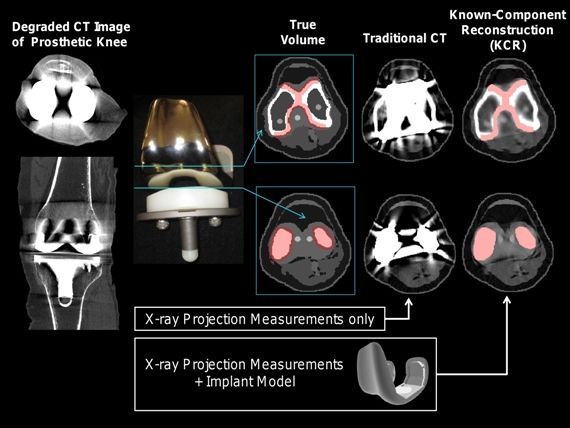- AI
- Molecular Imaging
- CT
- X-Ray
- Ultrasound
- MRI
- Facility Management
- Mammography
New CT Technique Shows Joint Implant Location
A new CT technique called known component reconstruction could produce improved images of joint replacements and lower dose exposure.
A new CT technique promises to produce improved images of joint replacements and may lower dose exposure, according to research presented this week at the annual meeting of the American Association of Physicists in Medicine.
Patients with knee, spine, and hip implants receive CT scans to assess the prostheses, fractures or infections, but the devices can interfere with the images. Images often include streaks or blurring.
To address these problems, researchers from Johns Hopkins University in Baltimore developed a method called known component reconstruction (KCR) which incorporates a model of the implant’s shape and material into the image reconstruction process. Combining iterative reconstruction with prior information about the implants provides location and orientation information, researchers said.
“We can get better image quality and specific information about placement of these devices,” said J. Webster Stayman, PhD, faculty research associate in biomedical engineering at Johns Hopkins University, speaking at an audio conference with reporters before the meeting. The information can be used for a preoperative plan and localization of the implants, he added.
Researchers are studying the method in clinical CT systems and assessing its potential use in hospitals. Lab studies using knee implants and surgical screws and rods used in spinal fixation have shown the method can be applied generally to CT machines.

Image courtesy AAPM
Comparative AI Study Shows Merits of RapidAI LVO Software in Stroke Detection
February 6th 2025The Rapid LVO AI software detected 33 percent more cases of large vessel occlusion (LVO) on computed tomography angiography (CTA) than Viz LVO AI software, according to a new comparative study presented at the International Stroke Conference (ISC).
The Reading Room: Racial and Ethnic Minorities, Cancer Screenings, and COVID-19
November 3rd 2020In this podcast episode, Dr. Shalom Kalnicki, from Montefiore and Albert Einstein College of Medicine, discusses the disparities minority patients face with cancer screenings and what can be done to increase access during the pandemic.
What Emerging CT Research Reveals About Obesity and Post-Op Survival for Non-Small Cell Lung Cancer
January 29th 2025For those without low skeletal muscle mass on CT and myosteatosis, obese patients have a 23 percent lower risk of death than non-obese patients after undergoing curative resection for non-small cell lung cancer, according to newly published research.
